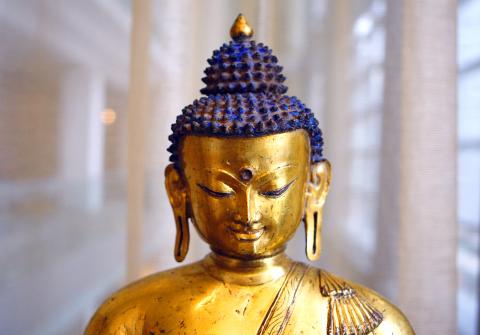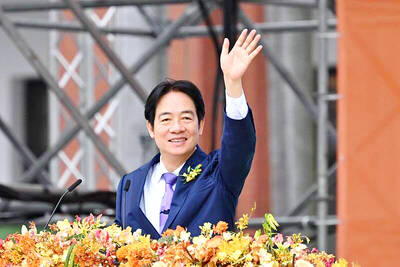On a rural American Indian reservation here, amid grazing horses and cattle, a Buddhist monk from the other side of the world is nearing completion of a US$1.6 million meditative garden that he hopes will draw spiritual pilgrims.
“There is something pure and powerful about this landscape,” said Gochen Tulku Sang-ngag Rinpoche, the 56-year-old Tibetan monk, as he walked down a gravel road on a sunny fall day. “The shape of the hills is like a lotus petal blossoming.”
Richard Gere has not been house shopping here — yet. But on the land of the Confederated Salish and Kootenai tribes, a 7.3m-tall statue of Yum Chenmo, the Great Wisdom Mother, has risen in Sang-ngag’s farm field. Nearby, in his old sheep barn, amid rubber molds and plaster, 650 statues of Buddha sit in neat rows, illuminated by shafts of light pouring in through broken boards.

Photo: Bloomberg
It seemed the perfect setup for a clash of two cultures when Sang-ngag, a high-ranking Buddhist monk, came to this remote part of Montana a decade ago, liked the landscape feng shui and bought a
24-hectare sheep ranch. At the foot of the towering, glacier-etched Mission Mountains — not unlike his native Tibet — he and a band of volunteers began building a Garden of 1,000 Buddhas to promote world peace.
The arrival of the exotic culture here in cowboy country, with multicolored prayer flags flapping in the breeze, made some from the Salish and Kootenai tribes uneasy, to say the least.
An unusual land ownership pattern was partly to blame. While most Indian reservations are majority-owned by the tribes, a 1904 law allowed nonmembers of the tribes to homestead land. And as a result, there are four to five times as many non-Indians on the reservation as there are Indians.
Sang-ngag called his place Ewam Sang-ngag Ling, or the Land of Secret Mantra, Wisdom and Compassion. It turns out that it was sacred to the tribes as well, a place where, oral traditions hold, a coyote vanquished a monster and drove out many bad spirits so the people could live here.
Julie Cajune, the executive director for American Indian Policy at Salish Kootenai College, and other Indians began working to build bridges between the tribes and the Buddhists. They suggested that the Buddhists bring traditional gifts, prayer scarves and tobacco, to the tribal council, which they did.
“Many people move here without recognition they are a guest,” Cajune said. “None of the mainstream churches or the Amish have done that.”
Buddhists in Japan, Taiwan and China have sent money for Buddha statues. The Dalai Lama has agreed to come and consecrate the Garden of 1,000 Buddhas after the project it is finished, perhaps in 2012.
But the patchwork of Indian and non-Indian land holdings within the reservation remains contentious. Some tribal members are worried that groups drawn to the Buddhist garden will buy up nontribal land, driving prices further out of the reach of Indians, and ignore tribal rules and customs.
They point to the case of Amish families who have bought farmland within the reservation, said Cajune, who is Salish.
“It’s ironic, but many Indian people can’t afford to buy land on their own reservation,” she said. A typical acre (0.4 hectares) for building a home here might cost US$30,000 — an enormous amount in rural and tribal Montana.
But Cajune said there was also an uncanny kinship between the tribal and Buddhist cultures, based on understandings of sacred landscapes, and even notions of honor and respect.
The biggest driver of rapprochement here is a shared history of subjugation and displacement — for the Tibetans, at the hands of the Chinese (Sang-ngag spent nine years in a Chinese labor camp) and for the tribes, by the US government.
“There is a shared vision of cultures being under pressure and surviving,” Sang-ngag said through a translator.
The heart of the 24-hectare development is the 4-hectare Garden of 1,000 Buddhas. When tribal elders came and blessed it, the two groups found they both used juniper and sage as purifying incense for ceremonies, for example, as well as similar prayer cloths and ritual drumming.
After much outreach by the Buddhists, including asking permission from the tribe to have the Dalai Lama consecrate the ground, Cajune said, “I think local people are feeling more comfortable.”
The sheep are gone from the green hills here now. “They achieved Buddhahood,” joked Sang-ngag as he walked through the garden, designed in the shape of the dharma wheel, which symbolizes the core teachings of Buddhism. The Great Wisdom Mother statue contains sacred vases and holy texts. Swords, guns and other symbols of war are buried underneath, to symbolize a triumph over violence.
In the Buddha barn, meanwhile, is a Harley-Davidson motorcycle, which members here jokingly refer to as the sacred chopper. It will be raffled to raise money to finish the garden. About half the money has been raised. At the end of last month the Buddhists began planning with the tribal officials about managing pilgrimages to the site, a possible headache for the tribe. “Some people want to keep the reservation a good, quiet secret,” Cajune said.
But Sang-ngag says good karma, or spiritual energy, is ebbing from the earth, and the garden will help enhance it. “It’s designed to awaken the Buddha nature” of wisdom and compassion in anyone who gazes upon it, said Lama Tsomo, a monk who lives nearby.
A potential cultural clash has become cultural reconciliation. “It’s two cultures honoring each other in peace,” Cajune said. “That’s a powerful story people need to hear.”

May 18 to May 24 Pastor Yang Hsu’s (楊煦) congregation was shocked upon seeing the land he chose to build his orphanage. It was surrounded by mountains on three sides, and the only way to access it was to cross a river by foot. The soil was poor due to runoff, and large rocks strewn across the plot prevented much from growing. In addition, there was no running water or electricity. But it was all Yang could afford. He and his Indigenous Atayal wife Lin Feng-ying (林鳳英) had already been caring for 24 orphans in their home, and they were in

On May 2, Chinese Nationalist Party (KMT) Chairman Eric Chu (朱立倫), at a meeting in support of Taipei city councilors at party headquarters, compared President William Lai (賴清德) to Hitler. Chu claimed that unlike any other democracy worldwide in history, no other leader was rooting out opposing parties like Lai and the Democratic Progressive Party (DPP). That his statements are wildly inaccurate was not the point. It was a rallying cry, not a history lesson. This was intentional to provoke the international diplomatic community into a response, which was promptly provided. Both the German and Israeli offices issued statements on Facebook

Even by the standards of Ukraine’s International Legion, which comprises volunteers from over 55 countries, Han has an unusual backstory. Born in Taichung, he grew up in Costa Rica — then one of Taiwan’s diplomatic allies — where a relative worked for the embassy. After attending an American international high school in San Jose, Costa Rica’s capital, Han — who prefers to use only his given name for OPSEC (operations security) reasons — moved to the US in his teens. He attended Penn State University before returning to Taiwan to work in the semiconductor industry in Kaohsiung, where he

President William Lai (賴清德) yesterday delivered an address marking the first anniversary of his presidency. In the speech, Lai affirmed Taiwan’s global role in technology, trade and security. He announced economic and national security initiatives, and emphasized democratic values and cross-party cooperation. The following is the full text of his speech: Yesterday, outside of Beida Elementary School in New Taipei City’s Sanxia District (三峽), there was a major traffic accident that, sadly, claimed several lives and resulted in multiple injuries. The Executive Yuan immediately formed a task force, and last night I personally visited the victims in hospital. Central government agencies and the